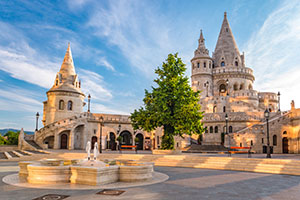Explore the great cities of Central Europe on a culturally rich independent journey, enjoying a private visit to the Liszt Academy of Music in Budapest, a tour of Vienna's Schönbrunn Palace and a visit to the Jewish Quarter in Prague.
Prague
Prague
Amid Prague's cobblestone streets and gold-tip spires, galleries, cafes, and clubs teem with young Czechs and "expatriates." New shops and restaurants have opened, expanding the city's culinary reach beyond the traditional roast pork and dumplings. The arts and theater also thrive in Prague. Young playwrights regularly stage their works, weekly poetry readings are standing room only, and classical music maintains famous standards, while the clubs are jammed. The arts - nonverbal theater, "installation" art, world music - are as trendy in Prague as in any European capital but possess distinctive Czech flavor. All of this is set against a stunning backdrop of towering churches and centuries-old bridges and alleyways. Prague achieved much of its glory in the 14th century, during the long reign of Charles IV, king of Bohemia and Moravia and Holy Roman Emperor. Charles established a university in the city and laid out the New Town, charting Prague's growth. Prague Castle is the most popular sight and is the largest ancient castle in the world with three courtyards.
|
Destination Guide
|
Vienna
Vienna
Vienna is dominated by imperial castles and places: Schonbrunn, the magnificent summer residence, the Imperial Coach Collection, the Palm House, the Butterfly House, Belvedere Palace, magnificent state rooms in Hofburg, and the imperial crown in the Treasury. Stop by Ringstraße - the showplace of the monarchy built where Emperor Franz Joseph ordered the demolition of city walls. Important buildings include the State Opera, the Museums of Fine Arts and Natural History, Parliament, City Hall and Vienna University. The world capital of music. A long line of great composers Johann Strauss, Haydn and Mozart, Beethoven and Schubert, Mahler and Schonberg all worked here. A city with splendid concert halls, such as the Golden Hall, from which the Philharmonic's New Year's Day concert is broadcast annually. International stars love to appear here in the State Opera, Volksoper, Konzerthaus, and at festivals like the Vienna Festival, the Klangbogen concerts during the Musical Summer, the Jazz Festval and the Haydn, Mozart and Schubert festivals.
|
Destination Guide
|
Bratislava
Bratislava
Bratislava is Slovakia's capital and largest city. The Carpathian Mountains, which begin at the Iron Gate of Romania, finally come to an end here. Vineyards on the slopes of the Little Carpathian Mountains meet the Danube River. The Austrian border is almost within sight of the city and Hungary is less than 15 miles away. Many beautiful monuments survive in the old town to tell of its past under Hungarian rule, and Bratislava's numerous museums are surprisingly rich. Franz Lizst visited Bratislava 15 times, and the opera productions of Slovak National Theatre rival anything in Europe. The old city, which is packed with museums and palaces, and the castle are the best parts of Bratislava - the rest of the city is pretty drab. Climb up the castle for great views and to check out the very interesting Museum of Folk Music within. The Slovak National Museum and the Slovak National Gallery on the river are also worth a visit. Hviezdoslavovo námestie (square) is a convenient orientation point, with the old town to the north, the Danube to the south, and Bratislava Castle to the west.
|
Destination Guide
|
Budapest
Budapest
Caught between eastern and western Europe, Budapest has a character uniquely its own. It's also the last cheap, civilised city in Europe. Budapest can seem like one big sight, with each phase in its history, from the Ottoman period until the Communist days and from renaissance to revolution, leaving its mark on the city. For the tourist, a trip to Hungary's capital is dominated by the majestic sights of Buda. In the summer, there are open-air festivals at Szeged, Diosgyor Castle in Miskolc, Gyor and Pecs. Visit the former Royal Palace complex, the Matyas templom and the Belvaros. Margaret Island is a giant recreational park and feels pleasantly separated from the city bustle. Hungarian National Gallery houses Hungarian art since the birth of the nation. Although Esztergom is Hungary's most sacred city, home of the Archbishop and the nation's biggest church, it has a real-life edge. The first-time visitor to Szeged is invariably struck by its space and grandeur. One's immediate impressions of Hungary's third largest provincial city are of greenery and plazas, of broad.
|
Destination Guide
|






